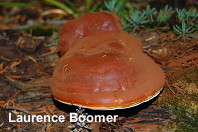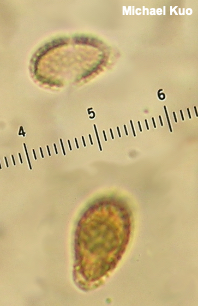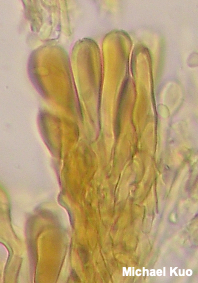| Major Groups > Polypores > Ganoderma > Ganoderma oregonense |

|
Ganoderma oregonense [ Basidiomycota > Polyporales > Polyporaceae > Ganoderma . . . ] by Michael Kuo Ganoderma oregonense is a medium-sized to very large polypore with a beautifully lacquered cap surface, found on the wood of conifers in the Pacific Northwest and California. Like other species of Ganoderma it has a brown-bruising pore surface, flesh that turns black with KOH, and interesting spores that feature double walls with a chambered appearance. Until recently the very similar Ganoderma tsugae was thought to coexist with Ganoderma oregonense in the Pacific Northwest, but recent study of hundreds of North American Ganoderma collections by Loyd and collaborators (2017, 2018) failed to support this idea; Ganoderma oregonense appears to be the sole conifer-associated, lacquered-topped species in the area (although Ganoderma polychromum shares the range of Ganoderma oregonense it features brown flesh and grows on the wood of hardwoods). Thanks to Laurence Boomer for collecting, documenting, and preserving Ganoderma oregonense for study; his collection is deposited in The Herbarium of Michael Kuo. Description: Ecology: Saprobic and sometimes parasitic; growing alone or in groups on decaying conifer logs and stumps, or from the wounds of injured, living trees; causing a white rot; annual; fall through spring; distributed in the Pacific Northwest and California. The illustrated and described collection is from Oregon. Cap: 10–50+ cm across; 5–15+ cm deep; more or less semicircular in outline, or irregularly kidney-shaped; surface with a lacquered-looking outer crust; brownish red or reddish brown overall, with or without a few paler zones; bald. Pore Surface: Whitish to pale brownish when young, becoming medium brown with age; bruising darker brown; with 2–4 circular pores per mm; tubes 1–3 cm deep. Stem: Usually absent; when present lateral and stubby, lacquered, brownish red to reddish brown. Flesh: Tough but not woody; whitish to creamy; without melanoid bands or concentric growth zones (see discussion). Odor and Taste: Not distinctive. Chemical Reactions: KOH instantly black on flesh. Spore Print: Reddish brown. Microscopic Features: Spores 11–16 6–8 µm including the hyaline vesicular appendix; more or less ellipsoid, with a truncated end; appearing double-walled, with a series of "pillars" between the walls; finely stippled; inamyloid; brown in KOH. Cystidia and setae not found. Hyphal system trimitic. Clamp connections present. Terminal cells on cap surface clavate; 7.5–12.5 µm wide; thick-walled; golden in KOH. REFERENCES: Murrill, 1908. (Overholts, 1953; Smith, Smith & Weber, 1981; Gilbertson & Ryvarden, 1986; Phillips, 1991/2005; Miller & Miller, 2006; Trudell & Ammirati, 2009; Desjardin, Wood & Stevens, 2015; Siegel & Schwarz, 2016; Loyd et al., 2017; Loyd et al., 2018.) Herb. Kuo 09301301. This site contains no information about the edibility or toxicity of mushrooms. |
© MushroomExpert.Com |
|
Cite this page as: Kuo, M. (2019, January). Ganoderma oregonense. Retrieved from the MushroomExpert.Com Web site: http://www.mushroomexpert.com/ganoderma_oregonense.html |


